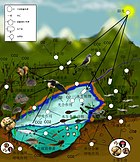海洋矽藻 屬於浮游生物 ,似乎無視了競爭排除原則 。 在水生生物學 中,浮游生物悖論 (英語:paradox of the plankton )描述的是有限的資源卻意外地支持了大量浮游生物 物種的情況,這顯然挑戰了競爭排除原則 ,即兩個物種競爭相同的資源時,有一個會佔劣勢而滅絕 。
生態悖論 [ 編輯 ] 浮游生物悖論 源於觀察到的浮游生物多樣性 與競爭排除原則 [1] [2] 物種 競爭 相同的資源時,最終只有一個物種能夠存續,而另一個會滅絕 。這樣的兩個物種之間是不可能共存的[3] 浮游植物 相互競爭的資源種類(例如光、硝酸鹽、磷酸鹽、矽酸、鐵)有限,但它們的生命在所有系統發生學 水平上都是高度多樣的。
浮游生物悖論最初由喬治·伊夫林·哈欽森 於1961年指出,他提出藉助光或湍流的垂直梯度、共生 或偏利共生 、差異捕食 ,或者環境條件不斷變化等因素,可以解決這一悖論。[4] [5] [6] [7] [8] 棲息地 永遠不會達到有利於單一物種的平衡。[9] [10]
參考文獻 [ 編輯 ]
^ Hardin, G. The Competitive Exclusion Principle. Science. 1960, 131 (3409): 1292–1297. Bibcode:1960Sci...131.1292H PMID 14399717 doi:10.1126/science.131.3409.1292 ^ Gause, G. F. Experimental Studies on the Struggle for Existence - I. Mixed Population of Two Species of Yeast . Journal of Experimental Biology. 1932, 9 : 389–402. doi:10.1242/jeb.9.4.389 ^ Johnson, Christopher A.; Bronstein, Judith L. Coexistence and competitive exclusion in mutualism . Ecology. 2019, 100 (6): e02708. ISSN 1939-9170 PMID 30924140 doi:10.1002/ecy.2708 (英語) . ^ Hutchinson, G. E. (1961) The paradox of the plankton . American Naturalist 95 , 137-145.
^ Károlyi, G., Péntek, Á., Scheuring, I., Tél, T., Toroczkai, Z. (2000) Chaotic flow: the physics of species coexistence (頁面存檔備份 ,存於互聯網檔案館 ). Proceedings of the National Academy of Sciences 97 , 13661-13665.
^ Wiggert, J.D., Haskell, A.G.E., Paffenhofer, G.A., Hofmann, E.E. and Klinck, J.M. (2005) The role of feeding behavior in sustaining copepod populations in the tropical ocean 互聯網檔案館 的存檔 ,存檔日期2008-09-05.. Journal of Plankton Research 27 , 1013-1031.
^ Miyazaki, T., Tainaka, K., Togashi, T., Suzuki, T. and Yoshimura, J. (2006) Spatial coexistence of phytoplankton species in ecological timescale Archived copy . [2007-06-06 ] . (原始內容 存檔於2007-09-27). Population Ecology 48(2) , 107-112.
^ Descamps-Julien, B.; Gonzalez, A. Stable coexistence in a fluctuating environment: An experimental demonstration (PDF) . Ecology. 2005, 86 (10): 2815–2824 [18 October 2014] . doi:10.1890/04-1700 原始內容 (PDF) 存檔於17 November 2006). ^ Scheffer, M., Rinaldi, S., Huisman, J. and Weissing, F.J. (2003) Why plankton communities have no equilibrium: solutions to the paradox . Hydrobiologia 491 , 9-18.
^ Mitchell, J.G., Yamazaki, H., Seuront, L., Wolk, F., Li, H. (2008) Phytoplankton patch patterns: Seascape anatomy in a turbulent ocean. Journal of Marine Systems 69 , 247-253.
外部連結 [ 編輯 ] 



